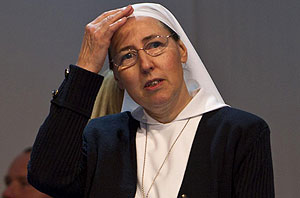Pope John Paul II beatified at Rome ceremony
Former pontiff moves closer to sainthood as Pope Benedict XVI declares him “blessed” in front of hundreds of thousands.

 |
| Groups carrying national flags and singing songs crowded St Peter’s Square for the ceremony [AFP] |
Pope John Paul II has been officially beatified at a ceremony attended by hundreds of thousands of people at St Peter’s Square in Rome.
Pope Benedict XVI on Sunday read a Latin formula proclaiming his Polish predecessor of the Roman Catholic Church, who died in 2005, “blessed”, the last step before sainthood.
Groups carrying national flags and singing songs crowded St Peter’s Square, which was bedecked with posters and photos of the late pope.
Up to 200,000 people attended a prayer vigil on Saturday evening in the Circus Maximus, the huge oval once used by the ancient Romans for chariot races.
Some Rome churches threw their doors open all night to give pilgrims a space to pray.
PR move
Al Jazeera’s Barbara Serra reported from Vatican City, “These last few years have been very difficult for the Catholic church with the paedophile cases erupting, and in some ways, Pope Benedict XVI, bearing the brunt of the criticism.”
“But right now, it is a moment of celebration, not just for those gathered here but also for the millions watching this on TV.
“So this apart from anything else, perhaps a good PR move on behalf of the Catholic church.”
The beatification only became possible after the Vatican confirmed after years of research a miracle attributed to John Paul’s intercession – the healing of a French nun, Marie Simon-Pierre Normand from Parkinson’s disease.
 |
| The Vatican said a miracle by Pope John Paul II cured Marie Simon-Pierre Normand [EPA] |
A place of honour is reserved for Simon-Pierre Normand, who spoke at Saturday’s vigil, paying tribute to John Paul as “a shepherd… who was closest to the weak, the sick and the young”.
The Vatican needs to prove a second miracle before John Paul can be revered as a saint but officials have hinted that this could happen soon.
Some 90 official delegations from around the world, including members of five European royal families and 16 heads of state, attended the beatification.
Pope John Paul’s coffin was exhumed on Friday from the crypts below St Peter’s Basilica and will be placed in front of the main altar.
It will then be moved on Monday to a new crypt under an altar in a side chapel near Michelangelo’s statue of the Pieta. The marble slab that covered his first burial place will be sent to Poland.
Dissenting voices
Thousands of pilgrims have swarmed into Rome in recent days ahead of the ceremony – travelling on specially chartered buses, ferries and planes.
John Paul’s beatification has set a new speed record for modern times, taking place six years and one month after his death on April 2, 2005.
The official Vatican daily, Osservatore Romano, called it “an extraordinary event without precedent in the last 1,000 years of the Church’s history”.
While the overwhelming number of Catholics welcome it, a minority are opposed, with some saying it happened too fast.
Liberals in the church say John Paul was too harsh with theological dissenters who wanted to help the poor, particularly in Latin America.
Some say John Paul should be held ultimately responsible for the sexual abuse scandals because they occurred or came to light when he was in charge.
Ultra-Conservatives say he was too open towards other religions and that he allowed the liturgy to be “infected” by local cultures, such as African dancing, on his trips abroad.
The pope was beatified on the day the Church celebrates the movable Feast of Divine Mercy, which this year happens to fall on May 1, the most important date on the calendar in the communist world.
The coincidence is ironic, given that many believe the pope played a key role in the fall of communism in Eastern Europe.
John Paul became pope in 1978 – the first non-Italian pope in more than four centuries.
He became known for his extensive foreign travel and succeeded in giving new strength to the Church before illness sapped his energies.
He died on April 2, 2005, from an acute case of Parkinson’s.